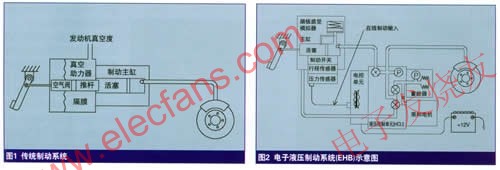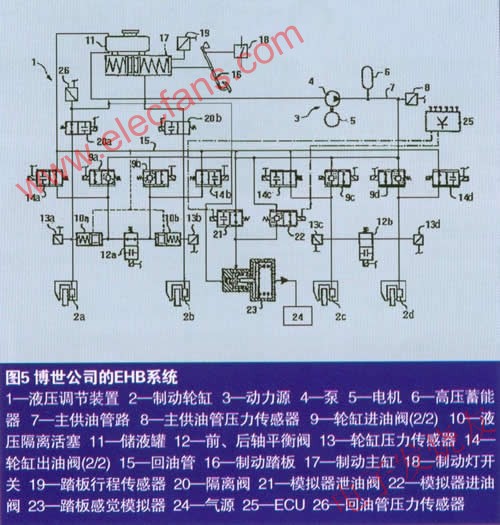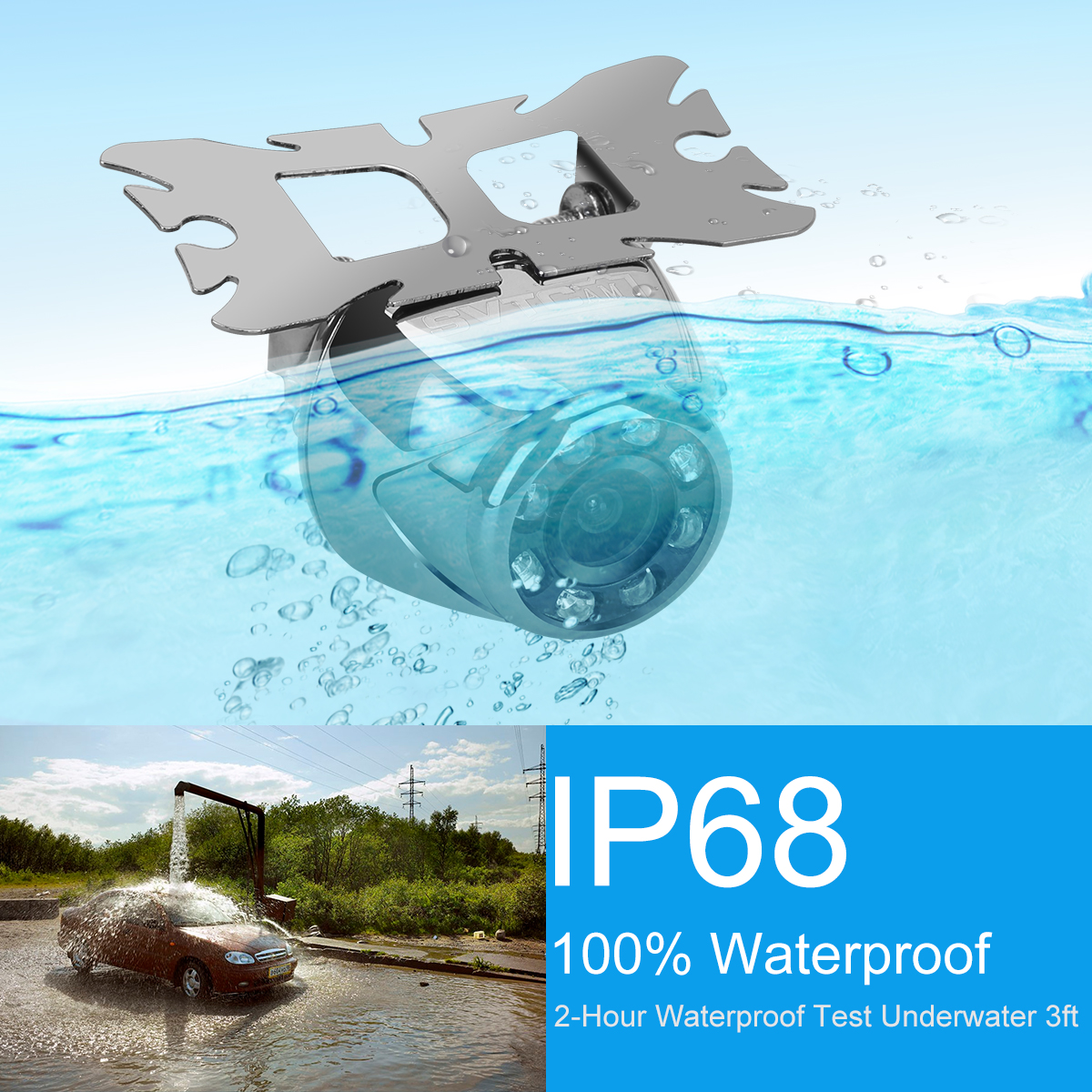EHB is a brake-by-wire system. It replaces some mechanical components with electronic components. The brake pedal is no longer directly connected to the brake wheel cylinder. Driver operations are collected by sensors as a control intent. The hydraulic actuator performs the braking operation, which makes up for the shortcomings caused by the design and principles of the traditional braking system, so that the brake control has the greatest degree of freedom, so as to fully utilize the road surface adhesion and improve the braking efficiency.
Development status of EHB system
As a relatively new type of braking system, EHB has a relatively short development time, but has broad development prospects. Major automobile manufacturers and research institutions are actively developing this system.
In 1994, Analogy developed a set of EHB control systems using Saber simulation methods. In 1996, Bosch carried out a real vehicle test of the EHB system it developed, and obtained satisfactory results. The system has also achieved great success in practical applications, and has obvious effects in shortening the braking distance and ensuring vehicle stability. . Tianhe, Delphi, Continental Tevez and other companies have also developed similar EHB systems, and obtained a series of patents from 2000 to 2002.
In September 2001, the new Mercedes-Benz SL sports car equipped with the Bosch Sensotronic Brake Control (Sensotronic Brake Control) system was first displayed at the Frankfurt International Motor Show. Equipped with Estate-type cars, in the same year, Bosch launched the four-wheel drive SBC, which was added to Mercedes-Benz E-Class 4maTIc cars for the first time. This was also the first time that the EHB system was applied to serial production cars. South Korea Mando Company, Continental Twice Company, Tianhe Company, etc. have all made progress in the development of the EHB system, and began to supply car manufacturers such as GM, Ford, Daimler Chrysler.
Advantages of EHB system
The traditional brake system is shown in Figure 1. The brake master cylinder and brake wheel cylinder are connected through a brake line. The brake pressure is directly input by human power through the brake pedal, and the vacuum booster as an auxiliary power source is also subject to the engine. Limitation of vacuum. This structural feature limits the establishment of brake pressure, the distribution of braking force of each wheel and the integrated control with other systems, and has limited potential for further improvement of the braking effect.
Figure 2 is a schematic diagram of the EHB system. Because the EHB system changes the pressure build-up method, the pedal force no longer affects the braking force, making up for the shortcomings caused by the design and principles of the traditional braking system. It has many advantages that the traditional braking system cannot match. :

1. In the traditional braking system, after emergency braking or long-term braking, the system component characteristics may change, which will affect the braking performance. Using the EHB control system, the change in the mechanical characteristics of the components can be compensated by the control algorithm to make The brake pressure level and pedal travel are always the same.
2. Due to the high pressure level of the accumulator, the high-pressure brake fluid enters the brake wheel cylinder through the control of the high-speed on-off valve, and the braking process is smooth and gentle. Under emergency braking conditions, the brake pressure rise gradient is large, and the brake pressure that can be reached is also higher. The brake shoe (caliper) accurately adjusts the brake pressure of the brake drum (disc) through the feedback of the wheel cylinder pressure sensor to eliminate brake noise.
3. The braking characteristics of the traditional braking system cannot be changed at will, and the EHB system analyzes the driver's intention to judge different braking behaviors and provides the most reasonable pressure change characteristics.
4. The traditional brake system can only achieve the distribution of front and rear brake pressure to a certain extent, while the EHB system has a great degree of freedom in the distribution of four-wheel pressure, which has a significant effect when braking on the road with different adhesion coefficients .
5. The traditional braking system with vacuum booster is affected by the engine speed and load, while the braking capacity of the EHB system is not affected by the engine vacuum.
6. Since the brake sensor detects the movement speed of the pedal and the stroke of the pedal, the electronic control unit adjusts the brake pressure accordingly. The manufacturer can only change the control algorithm according to different models and statistics of the driving habits of the driver. The pedal feel simulator provides a different pedal feel to the driver, making the EHB more portable.
7. When the traditional brake system performs ABS work, the pressure fluctuations in the brake pipeline make the brake pedal vibrate. Inexperienced drivers often unconsciously reduce the pedal force, which affects the braking effect. . EHB completely solves this problem because the pedal is not directly connected to the brake pipeline. It not only ensures that each wheel will not lock, but also releases the brake quickly, the braking process is safe and efficient, and has little effect on power loss.
In addition to the basic functions such as basic braking and ABS that the traditional braking system can achieve, EHB can also achieve other more excellent auxiliary functions.
8. When the vehicle is running on rainy or slippery roads, according to the action of the windshield wiper, the EHB system can issue a weak braking pulse at a fixed interval to dry the water film on the brake friction plate to eliminate The water decay phenomenon of the brake ensures reliable braking.
9. Most drivers will hesitate when applying braking force and insufficient pedal force when they encounter an emergency, resulting in a dangerous situation. EHB adjusts the braking force (identified and calculated by pedal stroke and pedal acceleration) by correctly identifying the driver's intention to avoid insufficient braking force.
10. When it is necessary to maintain the parking state, the system can apply a certain braking force to the wheels. Even if the driver releases the brake pedal, it can still produce a certain braking pressure on the wheels, reducing the burden on the driver and improving driving comfort. , To achieve electronic parking control EPB (Electric Parking Brake).
11. In the case of traffic congestion, the system cooperates with the accelerator pedal unit sensors to make judgments through the analysis and calculation of the electronic control unit. The driver only needs to control the accelerator pedal. Once the foot is removed from the accelerator pedal, the EHB system It will automatically apply a certain braking force to decelerate to stop. In this way, the driver does not need to frequently switch between the accelerator pedal and the brake pedal.
The composition and working principle of EHB system
As shown in Figure 2, the EHB system is mainly composed of a brake pedal unit, an electronic control unit (ECU), a hydraulic control unit (HCU), and a series of sensors.
1. Brake pedal unit
Includes pedal feel simulator, pedal force sensor or / and pedal travel sensor, and brake pedal. The pedal feel simulator is an important part of the EHB system, providing the driver with a pedal feel (pedal reaction force and pedal stroke) similar to the traditional braking system, so that it can perform braking operations according to its own habits and experience. Pedal sensors are used to monitor the driver's maneuvering intentions. Generally, pedal stroke sensors are used, and pedal force sensors are rarely used. Both are used at the same time to provide redundant sensors and can be used for fault diagnosis. Figure 3 shows the electronic brake pedal unit produced by Continental Twiss.

2. Hydraulic Control Unit (HCU)
The brake pressure adjustment device is used to realize the wheel pressure increase and decrease operation. Figure 4 shows the Continental Twiss EHB hydraulic control unit (HCU) with ECU.
The HCU generally includes the following parts:
Independent of the hydraulic control system of the brake pedal-This system has an energy supply system composed of a motor, a pump and a high-pressure accumulator. It is connected to the brake wheel cylinder through the brake line and directional control valve to control the inflow of brake fluid / Out of the brake wheel cylinder to achieve brake pressure control.
Human-driven emergency braking system-When the servo system has a serious failure, the brake fluid is driven into the brake wheel cylinder by the human-driven master cylinder, ensuring the most basic braking force to slow down the vehicle.
A balancing valve is set between the two brake wheel cylinders on the same side of the balancing valve. Except for the condition of independent braking control of the wheels, the balancing valves are all in the state of power off to ensure that the wheels on both sides of the coaxial Braking force balance.
3. Sensor
Including wheel speed sensor, pressure sensor and temperature sensor, it is used to monitor wheel motion status, feedback control of wheel cylinder pressure and correction control of different temperature ranges, etc.
Figure 5 shows a patent issued by Bosch on the EHB system. The system has a pedal feel simulation device, a set of hydraulic brake control of the service brake system and a set of human-operated emergency brake system. The servo system controls the pressure of the four wheels, while the human emergency braking system can only control the two front wheels. The system has 14 solenoid valves, all of which are two-position two-way valves.
During normal service braking, when the brake light switch is triggered, the electronic control unit determines that braking has occurred, the pedal stroke sensor senses the driver's braking intention, and then energizes to close the isolation valve, from the master cylinder under the action of human power The output brake fluid enters the pedal feel simulator, giving the driver the same feeling as when operating a traditional brake system.
The energy required for wheel braking is provided by the power source, and is sent to each wheel cylinder through the main oil supply line. The wheel cylinder inlet valve and outlet valve can realize the pressure control of each wheel cylinder. There is a balance valve between the two coaxial cylinders, which is used to maintain the coordination of the braking forces of the wheels on both sides during normal braking.

EHB control
The braking action to be realized by EHB is divided into basic braking and control braking.
The so-called basic braking means that the driver applies more or less pedal force according to his intention to control the deceleration of the vehicle and ensure his desired driving direction. The value of the pedal force is not yet enough to cause the wheels to lock up. . At this time, the EHB system must fully reflect the driver's intention and give the wheel driver the desired braking force.
Controlled braking refers to braking performed with necessary additional intervention. That is, when the driver wants to apply emergency full-force braking to the vehicle and depresses the brake pedal vigorously and quickly, the EHB system should recognize this requirement, while giving the wheel sufficient braking pressure, the wheel The braking pressure on the vehicle is controlled to prevent the occurrence of wheel lock, reduced braking stability of the vehicle, and so on.
The EHB system can also integrate a variety of vehicle control systems: when the vehicle starts or accelerates on a low-adhesion road and when the vehicle travels from a high-adhesion road to a low-adhesion road, the system integrates the anti-skid function; when the vehicle turns, the EHB system uses the wheel system Realize vehicle stability control; in addition, the aforementioned automatic water cleaning function, electronic auxiliary brake function, electronic parking brake function, etc. are all controlled brakes.
The EHB system has the superiority that the traditional braking system cannot compare with, but the EHB system still uses the electro-hydraulic control method. Strictly speaking, it is not a purely line-controlled braking system. Compared with the electromechanical braking system EMB, the EHB system is currently in use. The technology is more mature, so it has excellent development prospects in the short term.
Universal Backup Camera can fit virtually any vehicle,such as SUV,PICKUP,RV,SEDEN. High definition image, Resolution: 420 TV lines; Effective
pixels: 628 X 586 pixels. low power consumption design . The waterproof car rearview backup camera with IP68 rating,means when mounted,it is fit to operate in almost all weather conditions. 170 degree image angle , make you parking and
reversing more convenient.
Universal Backup Camera
Universal Backup Camera,Wired Mental Backup Camera,Car Backup Camera,Oem Backup Camera
Shenzhen Sunveytech Co.,LTD , https://www.sunveytech.com
